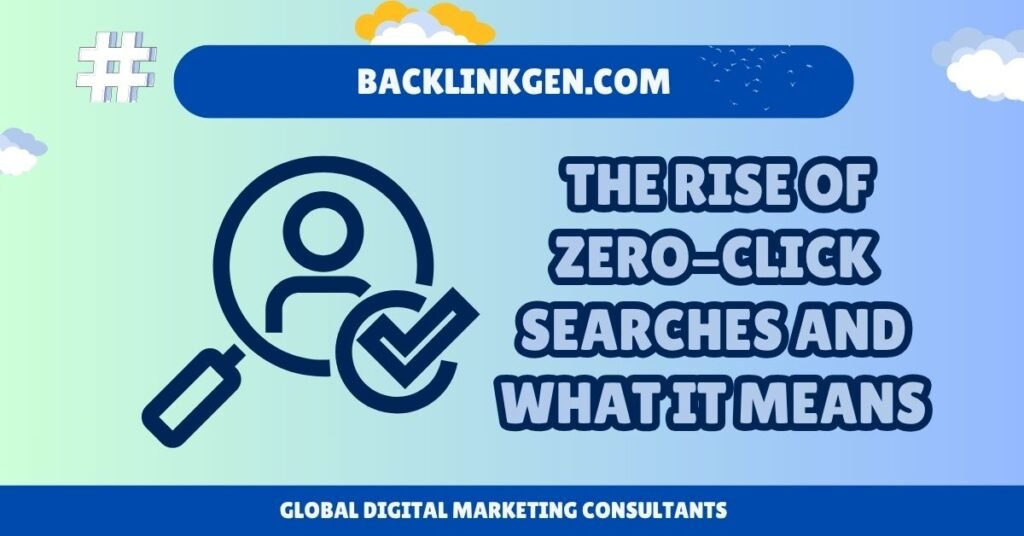In the world of SEO, one truth remains constant: Google is always evolving. And one of the most significant shifts in recent years is the rise of zero-click searches — where users get their answers directly from the search results page without ever clicking a website link.
As someone who has been managing SEO and paid media campaigns for 15+ years — across schools, colleges, and SaaS brands — I’ve seen how this trend has changed the very definition of “organic visibility.” The question now isn’t just how to rank on Google, but how to stay relevant when users no longer need to click.
What Exactly Are Zero-Click Searches?
A zero-click search happens when Google answers a user’s query directly on the search results page (SERP) through features like:
- Featured snippets
- Knowledge panels
- People Also Ask (PAA) boxes
- Google Maps results
- Instant answers (like weather, currency conversions, or time)
For example, if you search “time in New York,” “what is SEO,” or “how many grams in an ounce,” you’ll likely get your answer instantly — no website visit needed.
According to various SEO studies, more than 50% of Google searches in 2025 already end without a click. That’s half of your potential audience getting their answers before they even reach your website.
Why Are Zero-Click Searches Increasing?
There are three main reasons behind this trend:
1. Google’s Mission: Instant Information
Google’s core goal has always been to “organize the world’s information and make it universally accessible and useful.” The company has refined its search algorithms and interface to give users the fastest, most accurate answers possible. That means keeping users on the SERP longer — and reducing the need to click through.
2. Mobile and Voice Search Growth
Most zero-click activity comes from mobile devices and voice assistants. When someone asks Siri, Alexa, or Google Assistant a question, they want an immediate answer, not a list of links. That has pushed Google to display concise, structured information right in the results.
3. Rich Snippets and Structured Data
Google relies heavily on structured data (Schema markup) to generate enhanced results. Businesses that use it effectively may appear more prominently in SERP features like snippets or carousels — but ironically, that also means users might never visit their pages.
How Zero-Click Searches Impact Businesses
From a marketing standpoint, zero-click searches are a double-edged sword.
1. Reduced Website Traffic
Even if your content ranks #1 or appears in a featured snippet, you might see less traffic. Users get their answers on the SERP, so impressions increase, but clicks decline.
2. Decline in CTR (Click-Through Rate)
Traditional SEO metrics like CTR and average position become less meaningful when your top-performing keywords generate impressions without clicks.
3. Brand Visibility without Conversion
On the positive side, appearing in featured snippets or knowledge panels enhances brand authority and trust — even without direct traffic. Users see your brand as a reliable source of information.
4. Competitive Challenges
Zero-click results push small businesses to compete directly with Google’s own content — like Google Flights, Maps, or Reviews — and with major publishers optimized for snippet capture.
Types of Zero-Click Searches to Watch
- Featured Snippets – Concise answers extracted from web pages and shown at the top of the SERP.
- Knowledge Panels – Data drawn from authoritative databases like Wikipedia, Crunchbase, or Google My Business.
- People Also Ask Boxes – Dynamic Q&A boxes that expand with related questions.
- Local Packs (Maps) – Especially crucial for local SEO — users see phone numbers, ratings, and directions instantly.
- Instant Answers and Calculations – Google directly provides conversions, time, or sports results without external links.
Understanding which type affects your business is key to adapting your content strategy.
How Marketers Should Respond to Zero-Click Search Trends
This shift doesn’t mean SEO is dead — far from it. It just means our strategy needs to evolve. Here’s how:
1. Optimize for Featured Snippets
Structure your content with clear headers, bullet points, and concise answers. Use question-based subheadings like “What is,” “How to,” or “Why does.”
Example:
If your keyword is “How to set up Google Ads,” include a clear 2–3 sentence summary right under that header. That’s what Google pulls into snippets.
2. Focus on Brand Visibility
Even without clicks, visibility in SERPs still matters. Appearing in snippets, knowledge panels, or image packs builds awareness and authority.
3. Leverage Google My Business (GMB)
For local businesses — like schools, colleges, or service providers — optimizing your GMB profile ensures you appear in map packs and “near me” searches. Add photos, Q&A, reviews, and service details regularly.
4. Strengthen On-SERP Engagement
Add FAQs, schema markup, and video content. Google increasingly surfaces interactive media and structured data results, giving brands more control over their appearance on SERPs.
5. Drive Engagement Beyond Search
If fewer users click through, focus on what happens after they discover you. Build stronger presence on social media, use email funnels, and promote direct engagement channels like newsletters and webinars.
6. Create Content That Encourages Clicks
Offer value beyond what Google can summarize. Think:
- In-depth guides
- Original research
- Case studies
- Interactive tools
These create curiosity that forces users to visit your page for full insights.
7. Track Zero-Click Metrics
Use Google Search Console and GA4 to measure impressions, brand visibility, and engagement rather than clicks alone. It’s not about traffic volume — it’s about audience awareness.
8. Target Long-Tail and Conversational Queries
Longer, more specific queries often escape Google’s direct answers. For instance, “best CRM tools for education” or “how to integrate payment gateways in WordPress” — these still drive meaningful traffic.
Adapting as a Digital Marketer
At Kanity.in, our approach to SEO and digital growth for clients — including CRM SaaS companies, schools, and colleges — has evolved to meet this new reality.
We don’t just chase keywords anymore; we build visibility ecosystems across search, content, and social platforms.
That means combining:
- SEO visibility for snippets and voice queries
- Content marketing that encourages click-throughs
- Social engagement for brand awareness
- Paid search for conversion-focused traffic
This integrated model ensures we don’t lose value even when users stop clicking.
The Future: Search Becomes Experience-Based
By 2026 and beyond, Google’s ecosystem will focus on experience-based discovery — integrating AI-generated overviews, voice-driven results, and visual search.
That means content must serve two purposes:
- Inform users instantly.
- Entice them to explore further.
Marketers who master that balance — providing quick value while hinting at deeper insights — will win the next generation of search.
Final Thoughts
Zero-click searches aren’t killing SEO — they’re redefining it.
They remind us that digital marketing is no longer just about traffic, but about trust, visibility, and user experience. The goal isn’t always to bring users to your site — sometimes, it’s simply to be where they already are.
As Amit, my advice is this:
Keep adapting, keep testing, and remember — visibility without engagement is temporary, but authority lasts forever.

